Related Research Articles

Jasmine is a genus of shrubs and vines in the olive family of Oleaceae. It contains around 200 species native to tropical and warm temperate regions of Eurasia, Africa, and Oceania. Jasmines are widely cultivated for the characteristic fragrance of their flowers.
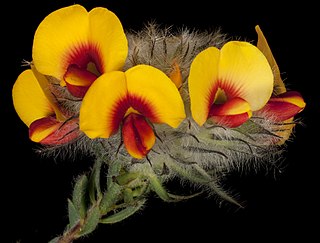
Urodon is a small genus from the family Fabaceae native to southwestern Australia. It includes two species of shrubs which grow in forest, woodland, and heathland.

Germplasm refers to genetic resources such as seeds, tissues, and DNA sequences that are maintained for the purpose of animal and plant breeding, conservation efforts, agriculture, and other research uses. These resources may take the form of seed collections stored in seed banks, trees growing in nurseries, animal breeding lines maintained in animal breeding programs or gene banks. Germplasm collections can range from collections of wild species to elite, domesticated breeding lines that have undergone extensive human selection. Germplasm collection is important for the maintenance of biological diversity, food security, and conservation efforts.

Dipteryx is a genus containing a number of species of large trees and possibly shrubs. It belongs to the "papilionoid" subfamily – Faboideae – of the family Fabaceae. This genus is native to South and Central America and the Caribbean. Formerly, the related genus Taralea was included in Dipteryx.
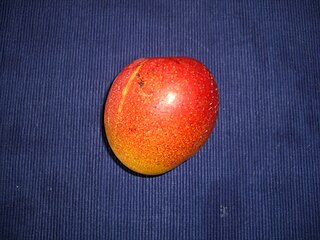
The 'Haden' mango is a named mango cultivar that became one of the most widely cultivated in the world after it was introduced in the early 20th century through south Florida. It would ultimately become the parent of many other mango cultivars later developed in Florida.
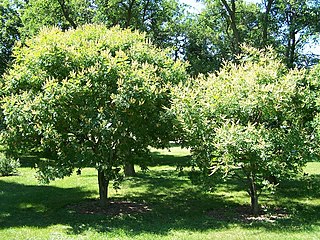
Maackia is a genus of flowering plants in the legume family, Fabaceae. There are 9 species, all native to eastern Asia, from China and Taiwan through Korea, Japan, and the Russian Far East. Six species are endemic to China. The generic name honors the botanist Richard Maack.

The 'Keitt' mango is a late-season mango cultivar which originated in south Florida.

Barklya is a genus of Australian trees in the legume family, Fabaceae. It belongs to the subfamily Cercidoideae. The sole species is Barklya syringifolia, commonly known as golden crown or golden glory. It grows in rainforest to 20 metres tall, and occurs in Queensland and New South Wales. It is often used as an ornamental.

Hypocalyptus is a genus of flowering plants in the family Fabaceae. It includes three species of shrubs, subshrubs or small trees native to the Cape region of South Africa. Typical habitats include Mediterranean-climate shrubland (fynbos) at forest margins, in rocky and sandy areas, and along streams, often at high elevations.
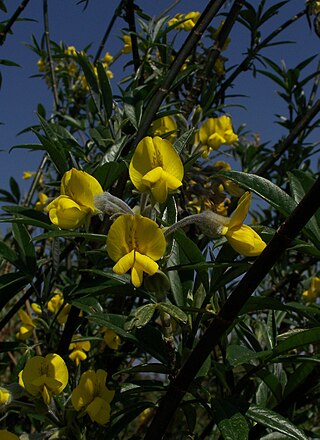
Piptanthus is a genus of flowering plants in the legume family, Fabaceae. It includes two species of shrubs native to the Himalayas, Tibet, Myanmar, and western China. They grow in montane grassland, thicket, and forest margins.

Aframomum corrorima is a species of flowering plant in the ginger family, Zingiberaceae. It is an herbaceous perennial that produces leafy stems 1–2 meters tall from rhizomatous roots. The alternately-arranged leaves are dark green, 10–30 cm long and 2.5–6 cm across, elliptical to oblong in shape. Pink flowers are borne near the ground and give way to red, fleshy fruits containing shiny brown seeds, which are typically 3–5 mm in diameter.
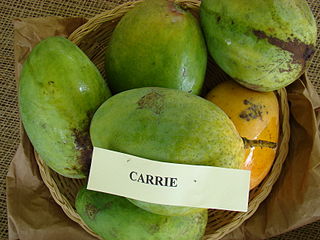
The 'Carrie' mango is a named mango cultivar that originated in south Florida, USA.

Bolboschoenus robustus is a species of flowering plant in the sedge family. It is known by many common names: saltmarsh bulrush, alkali bulrush, sturdy bulrush, seacoast bulrush, stout bulrush, three-cornered sedge or leafy three-cornered sedge, and seaside club-rush.
The U.S. National Plant Germplasm System (NPGS) is a network of institutions and agencies led by the Agricultural Research Service (ARS) of the U.S. Department of Agriculture in the effort to conserve and facilitate the use of the genetic diversity of agriculturally important plants and their wild relatives.
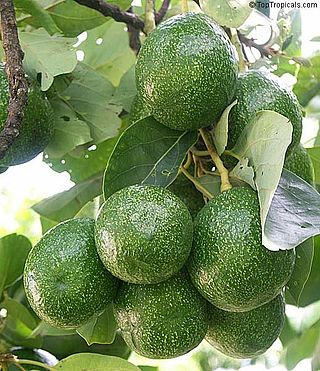
The Choquette avocado is a named commercial cultivar of avocado that originated in South Florida.

Polypremum is a flowering plant genus in the family Tetrachondraceae. The genus contains the single species Polypremum procumbens, commonly known as juniperleaf or rustweed. Polypremum has also been placed in the various families Buddlejaceae, Loganiaceae, Rubiaceae, and most recently in its own Polypremaceae.
Amphiodon effusus is a species of flowering plant in the family Fabaceae. It is a tree found in non-flooded areas of the Amazon rainforest. It is the only member of the genus Amphiodon.
Genesys is an online, global portal about plant genetic resources for food and agriculture. It is a gateway from which germplasm accessions from gene banks around the world can be easily found and ordered.
References
- ↑ National Research Council (U.S.); Committee on Managing Global Genetic Resources: Agricultural Imperatives (1991). The U.S. National Plant Germplasm System. National Academies Press. p. 139. ISBN 9780309043908.
- 1 2 3 "About us". Agricultural Resource Service. May 11, 2009. Archived from the original on May 27, 2012. Retrieved June 30, 2012.
- 1 2 3 4 5 6 Lipscomb, Barney L.; Pipoly, John James; Sanders, Roger William (2000). Floristics in the New Millennium: Proceedings of the Flora of the Southeast US Symposium. Vol. 18. BRIT Press. p. 90. ISBN 9781889878041.
- ↑ Miller, William; Pellen, Rita M. (2006). Evolving Internet Reference Resources. Vol. 1. Psychology Press. p. 386. ISBN 9780789030252. It gives 450,000 accessions (outdated; GRIN gives 500,000 as of June 2012).
- ↑ "Accession Area Queries". Germplasm Resources Information Network. Archived from the original on May 27, 2012. Retrieved June 30, 2012. It gives 500,000 accessions.
- 1 2 Ullrich, Steven E. (2011). Barley: Production, Improvement, and Uses. John Wiley & Sons. p. 149. ISBN 9780813801230.
- ↑ National Research Council (U.S.).; Committee on Managing Global Genetic Resources: Agricultural Imperatives (1991). The U.S. National Plant Germplasm System. National Academies Press. pp. 6, 96. ISBN 9780309043908.
- ↑ "GRIN-Global" . Retrieved March 31, 2020.
- ↑ "About GRIN". Germplasm Resources Information Network. Archived from the original on May 9, 2012. Retrieved June 30, 2012.